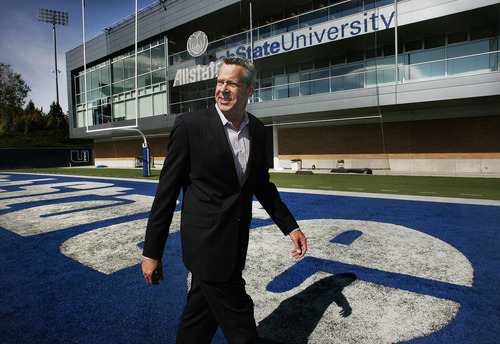This is an archived article that was published on sltrib.com in 2013, and information in the article may be outdated. It is provided only for personal research purposes and may not be reprinted.
Logan • The Utah State Aggies have a number of gleaming athletics buildings that have been erected in recent years.
The multimillion-dollar projects — a football complex, new locker rooms for basketball, a top-flight weight room, a training room and the soon-to-be-completed basketball and volleyball facility — all have something in common: They're primarily for the school's student athletes.
The time has come, athletic director Scott Barnes has said, to focus on serving Utah State's growing fan base. And the project he has in mind may be his biggest undertaking yet: renovating Romney Stadium.
This month, Utah State's athletic department has been conducting a feasibility study by an outside consulting firm to look at what fans want to change about the 46-year-old stadium and if the school can reasonably afford the wish list.
Even as the football team has been improving, Utah State's football home has kept a fairly low bar. Barnes bemoans the fact, for example, that luxury port-a-pottys must be hauled in every season because of the stadium's outdated restrooms.
"Romney Stadium is time-worn and not meeting the needs of the fan experience," Barnes said. "As we've grown our football program, it has become apparent."
To that effect, the Aggies are looking into upgrades throughout the venue, and not just the restrooms. That includes improving access from the concourse to seats, adding concession stands and building a new video board, among other ideas. Perhaps one of the most ambitious plans is to rebuild the press box to accommodate premium seating and boxes, which the athletic department sees as a significant revenue enhancers. Currently, they rent out a few rooms in the football complex in the north end zone.
"We don't have much premium seating options for fans," he said. "That product and the potential price point brings new fans and attracts a new kind of fan."
Depending on how much the construction will cost — Barnes said the first phase of such a project could run between $20 million and $30 million — the Aggies are looking to attract fans with hefty pocketbooks. Utah State's intent is to fund its biggest athletic construction project with outside sources that will likely involve the largest lead gift in department history. For reference, Jim and Carol Laub donated $5.25 million as the lead gift for the $9.5 million Estes Basketball Center over the summer.
But it won't just be donor checks that fund Romney upgrades. Barnes said the Aggies will look for new revenue streams, which may require out-of-the-box thinking. With the right financial plan and the money to carry it out, Utah State could be ready to hit the ground running sometime in the next few years.
There's no solid estimate, however, about just when that might be.
"We're talking about hunting elephants in terms of finding that lead gift, and we don't know when that might occur," Barnes said. "This isn't just one or two sources of revenue. We're going to really get creative and have be fortunate for what we need."
A fan survey and recommendations from focus groups will be presented in a steering committee meeting in December, Barnes said. An architect is helping estimate construction costs for the various upgrades. Barnes said attendance spikes this year mean the school is also considering expansion plans, although that might not happen concurrently with upgrades. —
Romney Stadium to-do list
• Some of the features Utah State is considering upgrading in the 46-year-old stadium:
• Increased overall access and circulation, including handicap options
• A new press box and luxury/premium seating
• A new jumbotron or video board —
Utah State vs. Wyoming
P Saturday, noon
TV • ROOT Sports





